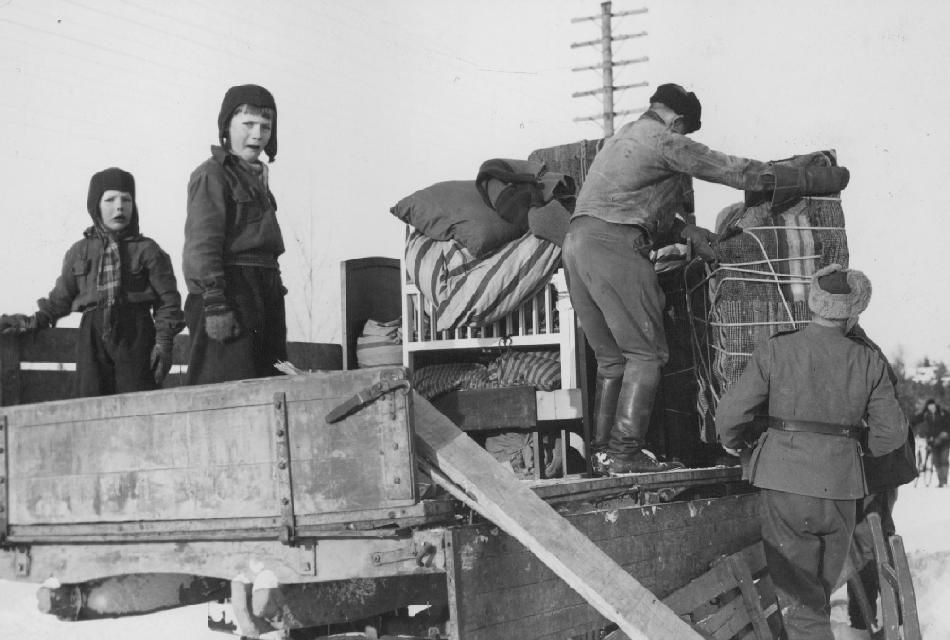
World War II Finland: The Winter War Peace Treaty--The Peace of Moscow (March 13, 1940)

Figure 1.-- Over 10 percent of Finland's population lived in the ceeded territories. The Treaty provided time for the population to move out of the territory to be turned over to the Soviets. Nearly all of the residents, about 0.4 million Finns, moved out of the ceded territory back to Finland leaving behind their homes, shops, and farms rather than live under Soviet rule. It is unclear to what extent this represented an historic fear of the Russians or fear of Soviet Communism. This German press photo was captioned, Winter War Refugees: Father seats his childten for the trip ton their new home."
|
|
The intense military phase of the Winter War ended with major Soviet advances (late-February 1940). Fighting dragged on at a low-level while the two countries conducted peace negotiations. Finnish forces were able to hold the front, but it was obvious that it was just a matter of time before the Soviets with their vast military capacity achieved a complete victory. Also the Finnish Government saw that foreign aid was not arriving. It is unclear why Stalin did not pursue the war to total victory. One factor may have been the huge losses sustained by the Red Army. The tarnashing of the Soviet image in the world press may have been a factor. We suspect that NAZI diplomats may have also intervened, but Hitler until he had succeeded in the West, did not want trouble with Stalin. Here we do not yet have details. We do know that Hitler was disturbed about the Soviet invasion. The two countries agreed to a cease fire (Match 13, 1940). The Soviets received very substantial concessions from the Finns. The Soviets obtained their security belt and more. The terms have been described as 'remarkably moderate terms'. [Hart] The territorial concessions focused on positions helpful in defending Leningrad in any future war. [Axell, p. 55.] On the whole, however, the Winter War had been embarassment to the Soviets. One Red Army General commented that just enough ground was won 'to bury our dead'. But this meant only that the Soviets did not occupy the entire country, as they had dome their share of Poland. Finland ceded substantial territories, land along the southeastern border approximately to the line drawn by the Peace of Uusikaupunki in 1721. This included Finland's second-largest city, Viipuri; the islands in the Gulf of Finland (the object of the 1938-39 negotiations), land in the Salla sector in northeastern Finland (near the Murmansk Railroad), Finland's portion of the Rybachiy Peninsula in the Petsamo area, and the naval base at Hanko on the Gulf of Finland for which the Soviets were given 30 year lease. This amounted to 10 percent of Finnish territory, including some of the country's most productive farmland. More importantly over 10 percent of Finland's population lived in the ceeded territories. The Treaty provided time for the population to move out of the territory to be turned over to the Soviets. Nearly all of the residents, about 0.4 million Finns, moved out of the ceded territory back to Finland leaving behind their homes, shops, and farms rather than live under Soviet rule. It is unclear to what extent this represented an historic fear of the Russians or fear of Soviet Communism. Finland managed, however, to salvage its independence. Historians debate why Stalin did not continue the War to its completion, the conquest of Finland. One historian writes, "Stalin was anxious to settle with Finland so he could turn his attention to Poland and the Baltic countries, which the Red Army would soon occupy and the NKVD would 'pacify' using terror, deportations, and executions." [Fischer] another factor may have been concern over the German reaction. Hitler did not react strongly because he was prparing his strike in the west. But a Soviet occupation of Finland would have changed the situation because it threatened weden which was Germany primary supplie of iron ore.
CIH -- WW II

Navigate the CIH World war II Section:
[Return to Main World War II Winter War page ]
[Return to Main World War II Finland page ]
[Return to Main Soviet World War II aggressions page]
[About Us]
[Biographies]
[Campaigns]
[Children]
[Countries]
[Deciding factors]
[Diplomacy]
[Geo-political crisis]
[Economics]
[Home front]
[Intelligence]
[POWs]
[Resistance]
[Race]
[Refugees]
[Technology]
[Totalitarian powers]
[Bibliographies]
[Contributions]
[FAQs]
[Images]
[Links]
[Registration]
[Tools]
[Return to Main World War II page]
[Return to Main war essay page]
[Return to CIH Home page]
Created: 4:21 AM 1/24/2016
Last updated: 4:21 AM 1/24/2016



